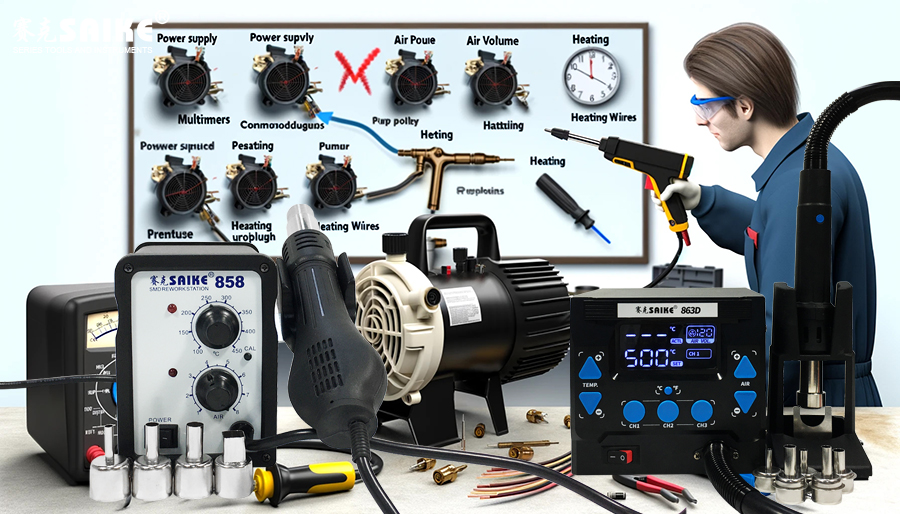
SK-YJ000RFQ-KP 100035
The hot air gun, as an essential tool, has a wide range of applications in fields such as electronic repair and handicrafts. However, during use, the hot air gun may encounter various failures that affect work efficiency. Therefore, it is particularly important to master the troubleshooting skills of the hot air gun. This article will introduce common fault simulations and troubleshooting methods for hot air guns in detail.
I. Power Supply Fault Simulation and Troubleshooting
1.Fault Simulation: Simulate a fault where there is no power indication by disconnecting the power cord or blowing the fuse.
2.Troubleshooting:
– Check if the power cord and fuse are intact. Replace them promptly if there is any damage or fusing.
– Use a multimeter to detect the power output, ensuring stable voltage and compliance with the hot air gun’s operating requirements.
II. Air Volume Fault Simulation and Troubleshooting
1.Fault Simulation: Simulate no air volume or low air volume fault by blocking the air pump outlet or adjusting the air pump gasket.
2.Troubleshooting:
– Clean the air pump outlet to ensure there are no obstructions.
– Check if the air pump gasket is aged or damaged and replace it if necessary.
– Adjust the air volume knob, observe changes in air volume, and ensure the knob functions normally.
III. Heat Fault Simulation and Troubleshooting
1.Fault Simulation: Simulate no heat or low heat fault by disconnecting the heating wire or adjusting the temperature control knob.
2.Troubleshooting:
– Check if the heating wire is intact. Use a multimeter to measure its resistance and ensure it falls within the normal range.
– Inspect the temperature control knob for damage and replace it promptly if faulty.
– Ensure good internal heat dissipation of the hot air gun to avoid overheating protection leading to no heat output.
IV. Other Common Faults and Troubleshooting Methods
1.The fan spins wildly, but the heating wire does not heat up:
– Check if the magnetic control switch is faulty. Use a multimeter to detect its conduction.
– Inspect the heating wire for burnout using a multimeter to measure resistance.
– Ensure the temperature-sensing resistor is not open-circuited, guaranteeing normal operation of the temperature control circuit.
2.Unstable temperature control:
– Clean the cooling fan to ensure its normal operation.
– Inspect the control circuit board and related components for faults.
V. Maintenance and Care
To reduce hot air gun failures, users should perform regular maintenance:
1.Regularly clean the dust and debris inside the hot air gun to keep the air path clear.
2.Inspect and replace aged gaskets and connecting wires.
3.Periodically check and replace the heating wire to ensure stable performance.
4.Pay attention to the usage environment, avoiding using the hot air gun in damp or excessively high temperatures.
VI. Summary
Through the above troubleshooting practice, users can become more familiar with the structure and working principles of the hot air gun, improving troubleshooting abilities and ensuring its normal use. Additionally, regular maintenance can effectively extend the hot air gun’s lifespan.


